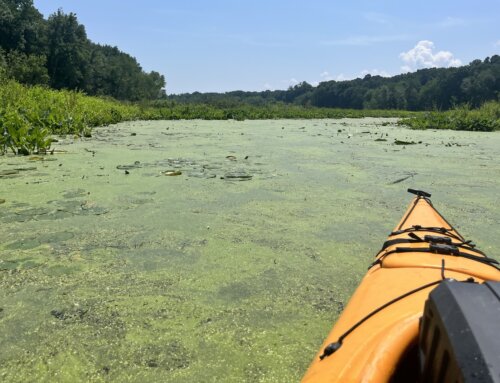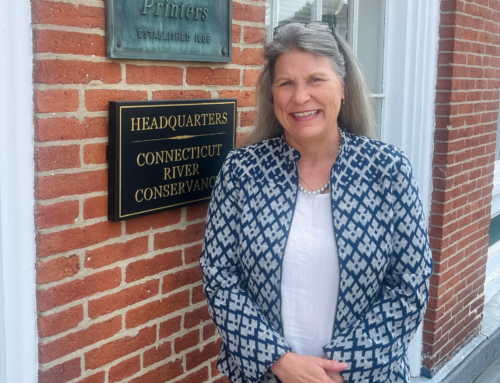Greenfield, MA. September 09, 2009. The Environmental and Natural Resources Law Center at Vermont Law School on behalf of the Connecticut River Watershed Council is preparing for oral arguments before the Vermont Supreme Court on September 15th in Newfane, VT. This is the final step in our appeal of the temperature increase amendment to the Entergy VT Yankee thermal discharge permit.
Vermont Yankee’s super-heated discharges—some as high as 105 degrees—create a thermal plume that has been shown to extend downstream at least fifty-plus miles to Holyoke Dam in Massachusetts. Higher river temperatures degrade the ecosystem and hurt migratory fish by inhibiting spawning and damaging the viability of eggs, adversely affecting feeding behavior, and increasing the incident of diseases and vulnerability to predation. Cool and cold water fish like American shad and Atlantic salmon are particularly susceptible to temperature increases and are the subjects of restoration programs due to their significant declines. Entergy’s own data show that the American shad population has declined by over 99% in Vernon Pool since the early 1990’s. CRC believes that allowing Entergy to continue to ratchet-up temperatures would be a serious misstep that could further impair the health of the Connecticut River and compromise restoration efforts.
In April of 2006, the Watershed Council took our appeal of the Vermont Agency of Natural Resources’ decision to allow warmer discharges to Vermont Environmental Court, an option of last resort for us. Entergy wanted to increase river temperature at Vernon an additional 1-degree Fahrenheit by bypassing their cooling tower system between May 16th and October 14th annually. In August of 2006 the Vermont Environmental Court granted its first stay on the issue pending the appeal, stating, “Appellants have shown sufficient potential for irreparable injury to American shad in the Connecticut River, both at present as the juveniles become accustomed to cooler water temperatures prior to their migration down the River in the fall, and in the summer of 2007 for the growth of the next generation of juveniles.”
Joining us in the appeal were Trout Unlimited, and the Citizen’s Awareness Network. CRC’s partner and chief council throughout the case have been the skilled staff of Vermont Law School’s Environment and Natural Resources Law Center. This includes senior staff members as well as interns. In all, VLS has logged thousands of volunteer hours—doing yeoman’s work on behalf of CRC, its partners, and the river. Out front and in the background as always has been David Deen, CRC River Steward for Vermont and New Hampshire.
Leading up to the trial, Entergy dipped into their pool of extensive corporate resources calling upon five full-time attorneys and four consultants in an attempt to stymie CRC’s case. In the process they filed three motions to either dismiss the case or narrow its scope. All were denied. The courtroom aspect of the appeal finally got underway in late-June yes taking up the full eight days scheduled for testimony, which, with breaks, did not conclude until late July.
In the end, Entergy submitted over 200 objections to our testimony. These were either rejected or reduced to minor wording changes by the Court. The case presented by our council was so strong that Entergy petitioned the judge for two additional trial days to question our experts. Senior attorney Pat Parenteau, Director David Mears, and staff attorney Ben Rajotte as well as that host of student interns, put our post trial memo and request for findings before the Court in early October. They also executed our reply brief, filed October 29th, with the CRC/VLS team working long night and weekend sessions in order to answer the 900+ contentions in the Entergy final filing.
The Vermont Environmental Court decision was a mixed message on the temperature increase of the river. The date of possible increase was moved back until later in July from the originally requested date of May 16th and a new temperature limit was set by the Court for water passing through the upstream fish passage ladder at Vernon. The Court upheld the new temperature maximum for the entire river that had never existed and would not now exist if CRC had not appealed the permit.
Yet CRC was not satisfied with whether or not the E Court applied the correct legal standards for issuing variance permits under federal law. The Court chose not to hold Entergy VY accountable for prior harm to the aquatic habitat and biota. CRC had convincing evidence that was disallowed in the Court proceeding that we feel should have been introduced and CRC questions whether the Court properly applied the Vermont Water Quality Standards for the Connecticut River as Class B waters. For these reason CRC appeal the Environmental Court decision to the VT Supreme Court.
These issues are now before the Vermont Supreme Court. A decision is expected this fall after the oral arguments in September.
# # #
For press information contact: Chelsea Gwyther, Executive Director, CRC, at: (413) 772-2020, ext. 202.
Connecticut River Watershed Council has been a non-profit advocate for the 11,000 square-mile watershed of the Connecticut River emphasizing fisheries restoration, erosion prevention, land conservation, and water quality since 1952.







